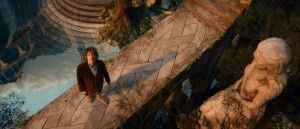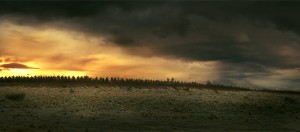The Ending II: The Eagles are changing!

The Eagles of the Misty Mountains were, after all, “not kindly birds,” so immediately after the rescue, let’s make them surprisingly inimical to Thorin and Company. Why might they rescue them and then be unfriendly? It’s a puzzle, but by no means an impossible one for the screenwriters to solve. For instance, they might mistakenly believe Gandalf and the dwarves responsible for some hurt or harm, and desire to interrogate them and, if appropriate, punish them themselves. This twist would essentially end the movie with “out of the frying-pan, through the fire, then down the garbage disposer,” to coin a proverb you’re unlikely to ever hear again.
At first glance, this might seem like adding obstacle for its own sake, and it will certainly remind some viewers of Treebeard’s surprise initial decision not to attack Isengard. But there’s another reason to turn the Eagles sequence on its head, one I feel Jackson will find irresistible. In the book, it’s noted that Gandalf had once healed the Lord of the Eagles of an arrow-wound, thus beginning the great friendship between Gandalf and the Eagles that reaches its apotheosis near the end of LOTR.

And that in turn would change the dramatic impact of both the Eagles’ tide-turning arrival at the Battle of Five Armies and (for future viewers of the films in chronological order) near the end of ROTK. “The Eagles are coming!” is an exquisite example of what Tolkien, in his groundbreaking essay “On Fairy-Stories,” called eucatastrophe, the sudden unforeseen turn for the good that causes the heart to catch, and which is an essential component of the classic fairy-tale. (It occasionally crops up in realistic narratives, too, including one of the most critically acclaimed films of the last few years. Note that simply knowing that there is a eucatastrophe, even without knowing what it is, spoils the ending, so click at your peril if you want to know which one.)
The only problem is that he used the exact same eucatastrophe outside the gates of Mordor. Changing the Eagle story in The Hobbit, though, would give the two eucatastrophes very different dramatic flavors.
The arrival of the Eagles in any version of The Hobbit will always be an unexpected thrill, but the full emotional palette that blooms in the next few moments, as we think about the story, depends on the dramatic circumstances. In the book, their participation in the Battle is essentially a gift, since even if the reader remembers the bit about the arrow-wound, that debt has already been repaid with the treetop rescue. By putting Gandalf’s favor to the Eagles into the story, after the rescue, we turn their arrival at the Battle into something our heroes have earned, into a payoff. We’ve created a causal connection between the earlier Eagle episode and the victory in the Battle, whereas in the book they are both the result of an event long ago.

Ordinarily I would regard this change as a mixed blessing, because there’s something to be said, after all, for having the Eagles arrive and save the day for no reason other than that they want to. But that is what we’ll see three movies later near the end of ROTK, where it will be especially gratifying now that we know the whole story. Changing the flavor of The Hobbit eucatastrophe is a win-win when it makes ROTK’s unique.


